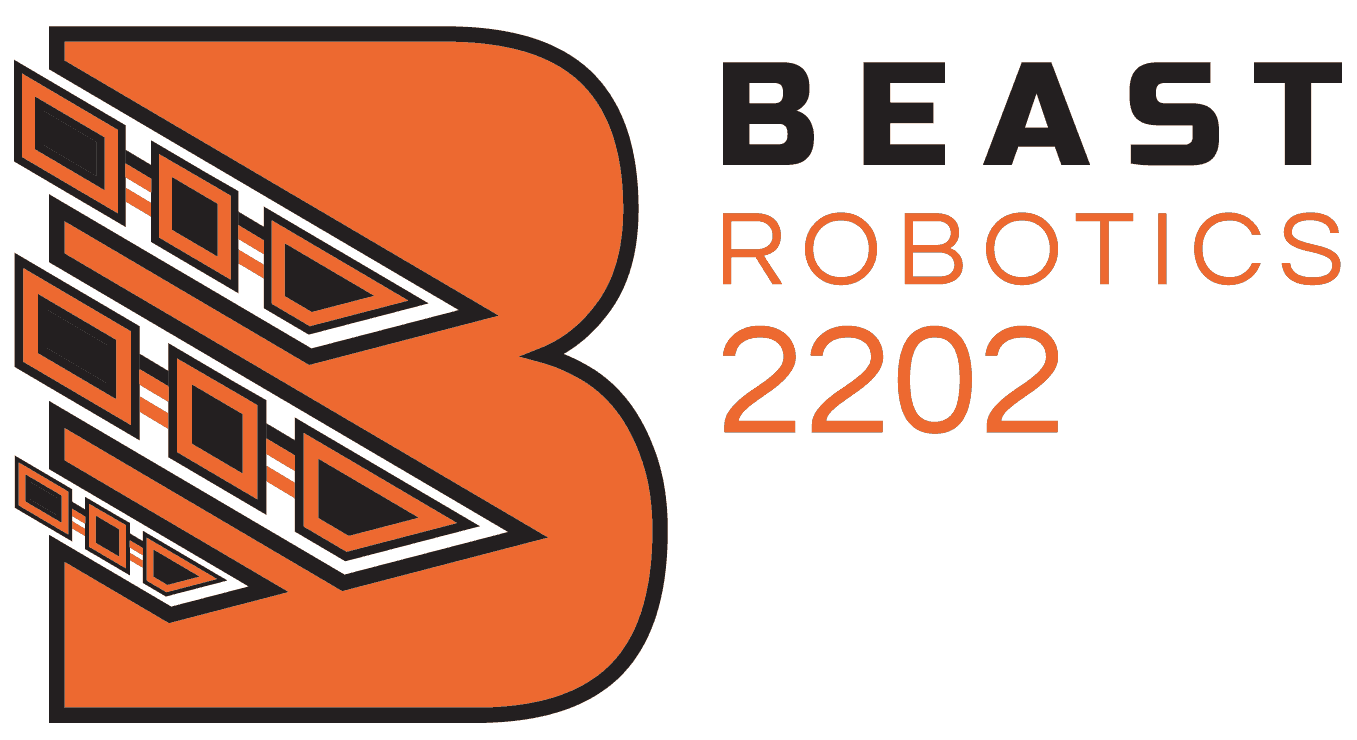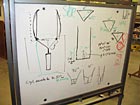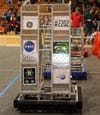The 2013 Robot
 The 2013 season challenge was Ultimate Ascent. The objective of the game was to shoot Frisbees through multiple goals for varying points. There were three levels of goals; one high goal, one middle goal, and one low goal, each worth 3, 2, and 1 point respectively. The end game bonus was to climb a 90 in, three tiered metal pyramid, with varying points for the height that the robot reaches.
The 2013 season challenge was Ultimate Ascent. The objective of the game was to shoot Frisbees through multiple goals for varying points. There were three levels of goals; one high goal, one middle goal, and one low goal, each worth 3, 2, and 1 point respectively. The end game bonus was to climb a 90 in, three tiered metal pyramid, with varying points for the height that the robot reaches.
To launch Frisbees, we built a shooter made of two motors and pneumatic tires to get the Frisbees across the field of play and into their designated goal. To climb the pyramid, we used a design similar to a hook, so we could drive up to the pyramid at a decent speed, and simply hang.
The 2012 Robot
The 2012 season game was Rebound Rumble. The objective of the game was to score points by having your robot shoot baskets. There were four baskets shaped in a diamond. There was a bottom level basket, two middle level baskets, and a top level basket, worth one, two and three points respectively. The endgame bonus was to balance on one of the three bridges that lined the middle of the field. The bridges were able to support up to three robots.
To shoot the basket, we decided to have a conveyor belt bring our balls to the shooter: two motors that fire the ball and can run at different speeds. To cross and balance the bridge, we used a pneumatic system to deploy an arm that would push the bridge down. From the season, we learned the value of having a prototype model for the programming. We also learned that it is great for a robot to have a lower center of gravity for this particular challenge.
The 2011 Robot
 The 2011 season game was Logomotion. The objective was to hang colored inner tubes onto a rack. The rack had 9 spots and if a team managed to get 3 tubes forming the FIRST Logo in a row, the score for those tubes would be doubled.
The 2011 season game was Logomotion. The objective was to hang colored inner tubes onto a rack. The rack had 9 spots and if a team managed to get 3 tubes forming the FIRST Logo in a row, the score for those tubes would be doubled.
As an endgame challege, the robots would deploy minibots onto poles, which would climb to the top. To lift the tubes, our team decided to use an arm that could pick up tubes from the ground and reach the top row. A few prototypes were constructed, and we eventually settled on an arm with only a shoulder joint with a pneumatic gripper and a spatula-like platform to scoop up tubes. A seperate team worked on a minibot with magnets and a concave wheels, while another debated over how the minibot would be deployed and oriented.
The deployment proposals included worm gears, belts, and slingshots, but we eventually settled on a pneumatic deployment system. After ditching the idea to use a wedged piece to orient the minibot, a curved piece of plastic conforming to the base of the tower was added to the robot.
The B’East Robot in “Logomotion”
At the competitions, the robot performed very well, doing everything we intended it to, especially the arm. Because of the arm’s simultaneous simplicity and effectiveness, our team recieved the Industrial Design Award. Our robot is an example of what the engineering process, as well as hard work, can accomplish. It looks like our team will continue to outperform ourselves well into the future.
The 2010 Robot
The 2010 robotics challenge was Breakaway, where the robots would launch soccer balls into goals at the end of the field. There was also an endgame challenge of elevating the robot, suspending it from poles to score extra points. After an extensive risk analysis, our team decided not to create a suspendable robot and to focus our limited time and energy on the main objective.
Watch the 2010 B’EAST Robot In Action
A breakthrough on the ball kicker came when an ingenious crank-operated kicker was introduced. A wheel would draw back the kicker, and a bolt threaded through the wheel would hold it in place. When the wheel moved again, the rod holding the kicker would slip past the bolt and release the kicker. In addition to the kicker, we also repurposed a vacuum impeller and painstakingly connected it to a suction cup near the kicker, which effectively held the ball in place. Combined with excellent programming and electronic work, our robot was a real beast at the competition.
The 2009 Robot
The 2009 season game was Lunacy. The objective was to launch balls into the trailers of the robots on the opposing team. Also, the playing floor was covered with a low-friction surface, simulating the lack of traction in a lunar-gravity environment. We went through the usual steps of the engineering process: brainstorming, design, prototyping, testing, retesting, etc. Features of the robot included a rotatating turret that would launch the balls, and a covevor to act as a hopper for the balls. One design proposal that worked suprisingly well was a spinning wheel with claw-like protrusions. In the qualifying rounds, BEAST Robotics lost every game, but because of the robot’s excellent design, we got a chance to compete in the elimination rounds. The season and the robot demonstrated the values of good design and ingenous ideas.
The 2008 Robot
In 2008, an efficient robot was able to be fast, easily handle the ball, and hurdle the bar. The design for this objective combined a scissors jack equipped with a circular hoop to safely hold the ball, a pickup and raising arm to move the ball from the ground onto the hoop, and a piston at the top of the scissors jack to ‘pop’ the ball over the bar.
This combination allows for separate control with two drivers; one controlling the actual robot, and one controlling the height of the scissors lift along with the ball ejector. All in all, this design was relatively light, under 105 pounds. This allows for a higher acceleration of the robot with the standard CIM motors and AndyMark transmissions.
The 2007 Robot
The two main strategies in 2007 were mainly either to hang tubes up on the rack to score low points in high quantities, or to raise one or both of your alliance members a foot or higher off the ground for big points. Our team went for the second strategy. Our motto for the season was to keep it simple and we certainly followed through with that plan.
The design involved two large ramps calculated to the maximum length possible in order to both be under the six foot limit and be capable of raising two robots a foot off of the ground. When the ramps fold out, one was at an angle with the ground and the other was just above a foot to allow for deflection but still be at the right height.



